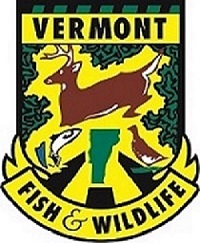
The Vermont Fish and Wildlife Department has proposed issuing 100 moose hunting permits in Vermont’s Wildlife Management Unit (WMU) E in the northeastern corner of the state in order to reduce the impact of winter ticks on the moose population. The proposal was accepted by the Vermont Fish and Wildlife Board at its February 16 meeting.
“Department staff, including moose project lead biologist Nick Fortin and biometrician Dr. Katherina Gieder, brought incredible scientific expertise to this recommendation,” said Commissioner of Fish and Wildlife Christopher Herrick. “The proposal our board vetted and approved was informed by years of field research and sophisticated statistical analyses that have been featured in peer reviewed publications alongside results from sister efforts in Maine and New Hampshire.”
The goal of the department’s 2022 moose harvest recommendation is to improve the health of moose in WMU-E by reducing the number of moose and thereby reducing the abundance and impact of winter ticks.
“Moose density in WMU E is still more than one moose per square mile, significantly higher than any other part of the state,” said Nick Fortin, Vermont Fish and Wildlife’s moose project leader. “Moose densities greater than one per square mile support high numbers of winter ticks which negatively impact moose health and survival.”
The Fish and Wildlife Department partnered with University of Vermont researchers to conduct a study of moose health and survival in WMU E. The results of this study, in which 126 moose (36 cows, 90 calves) were fitted with GPS tracking collars, clearly showed that chronic high winter tick loads have caused the health of moose in that part of the state to be very poor. Survival of adult moose remained relatively good, but birth rates were very low and less than half of the calves survived their first winter.
“Research has shown that lower moose densities in the rest of Vermont support relatively few winter ticks that do not impact moose populations,” said Fortin. “Reducing moose density decreases the number of available hosts which in turn decreases the number of winter ticks on the landscape.”
The department would issue 60 either-sex moose hunting permits and 40 antlerless moose permits in WMU-E for the moose seasons this October. This is expected to result in a harvest of 51 to 65 moose, or about 5 percent of the moose population in WMU-E. The same number of permits were issued in 2021 when hunters took 62 moose.
“This permit recommendation represents a continued attempt to address winter tick impacts on moose in WMU-E,” added Fortin. “Given the poor health of the moose population in that area and a clearly identified cause, we need to take action to address this issue. Without intervention to reduce the moose population, high tick loads will continue to impact the health of moose in that region for many years.”
The 2022 Moose Season Recommendation and information about the moose study are available on Vermont Fish and Wildlife’s website at www.vtfishandwildlife.com. Comments may be provided until March 31 by emailing ANR.FWPublicComment@vermont.gov or by calling and leaving a message on the Vermont Fish and Wildlife public comment voicemail at 802-828-7498.
For Immediate Release: February 17, 2022
Media Contacts: Nick Fortin 802-793-8777; Mark Scott 802-777-4217; David Sausville 802-324-4206
